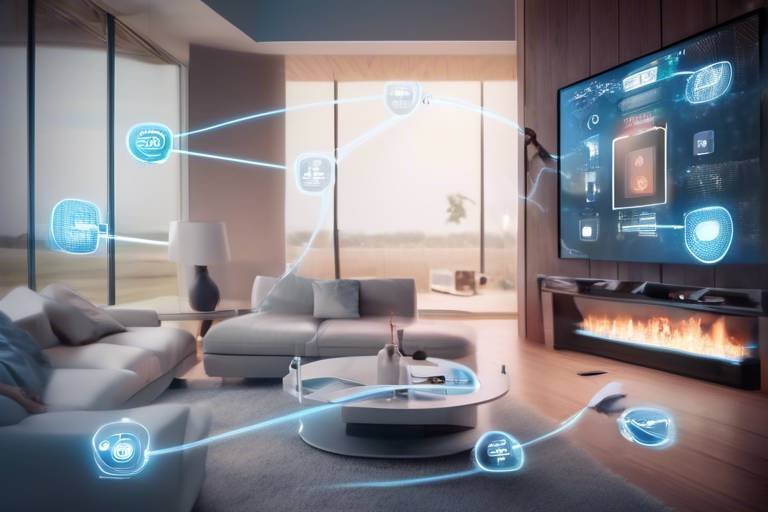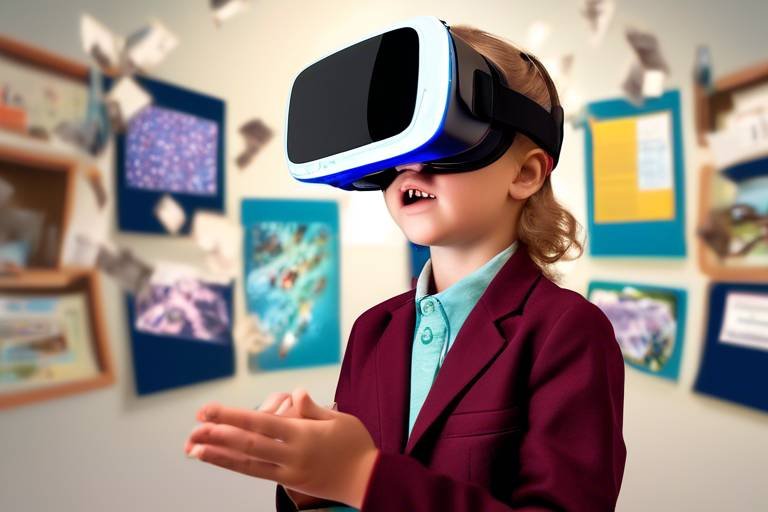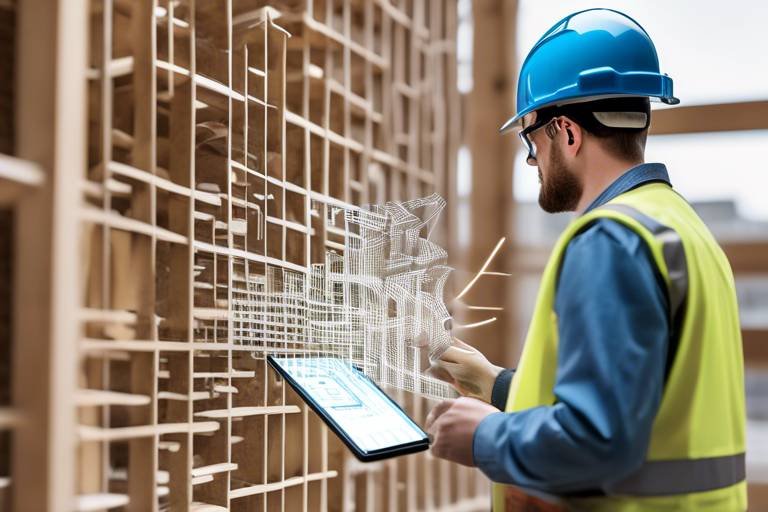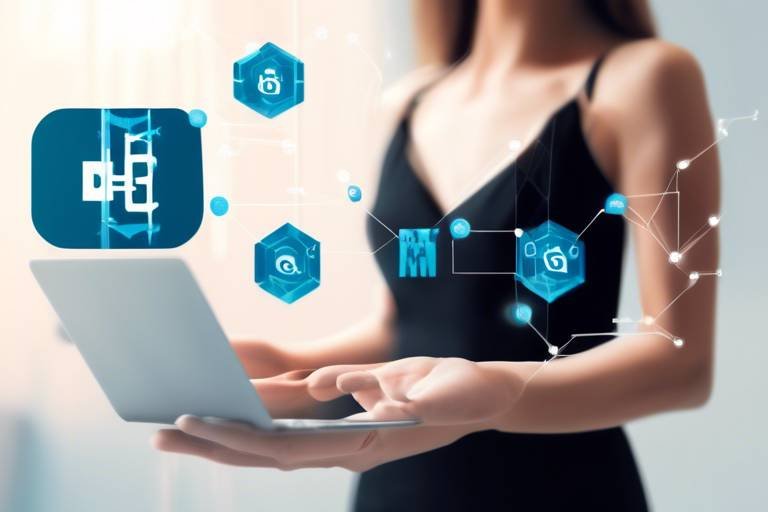Innovations in Biometric Identification Technologies
In today's fast-paced world, the need for secure and efficient identification methods has never been more crucial. Traditional methods like passwords and PINs are becoming increasingly inadequate, leading to a surge in the adoption of biometric identification technologies. These innovative systems utilize unique physical or behavioral traits—such as fingerprints, facial recognition, and even voice patterns—to verify identities. This article dives deep into the latest advancements in biometric technologies, exploring their applications, benefits, and the challenges they face across various sectors like security, healthcare, and finance.
As we explore the cutting-edge innovations in biometric identification, it's important to understand that these technologies are not just about security; they also enhance user experience. Imagine walking into a bank where your face is recognized by the system, allowing you to access your account without fumbling for your card or remembering a password. Or think about how voice recognition can streamline customer service interactions, making them faster and more efficient. The possibilities are endless, and as we delve into the details, you'll see how these technologies are reshaping our daily lives.
However, it's not all smooth sailing. With great innovation comes great responsibility, and the implementation of biometric systems raises significant security concerns. Issues like data privacy, potential misuse of biometric data, and the risk of hacking are critical challenges that need to be addressed. As we navigate through this article, we'll also discuss how these challenges can be mitigated and what the future holds for biometric identification technologies.
Join us on this journey as we uncover the fascinating world of biometric innovations. We'll explore emerging modalities, the integration of artificial intelligence, and how these technologies are revolutionizing various industries. Buckle up; it's going to be an exciting ride!
Biometric identification is a method that uses unique physical or behavioral characteristics for personal identification. Unlike traditional identification methods, which rely on something you know (like a password) or something you have (like an ID card), biometrics is based on who you are. This section will delve into the fundamental principles of biometric identification and discuss the various types of biometric modalities currently in use.
These modalities can be broadly categorized into two types: physiological and behavioral. Physiological traits include fingerprints, facial recognition, iris scans, and voice patterns, while behavioral traits encompass gait analysis, keystroke dynamics, and signature verification. Each method has its strengths and weaknesses, making them suitable for different applications.
As technology evolves, so do the methods of biometric identification. New modalities such as voice recognition and gait analysis are gaining traction, offering innovative ways to enhance security and user experience. This section will examine these cutting-edge methods and their potential applications.
Voice recognition technology is revolutionizing user authentication by allowing devices to recognize and process human speech. The mechanisms behind this technology involve advanced algorithms that analyze various aspects of a person's voice, including pitch, tone, and accent. As this technology becomes more sophisticated, its accuracy has significantly improved, leading to a growing usage in personal devices and customer service applications.
In the realm of customer service, voice recognition is increasingly being utilized to streamline interactions. Imagine calling a customer service hotline where the system recognizes your voice and retrieves your account information instantly. This not only improves response times but also enhances user satisfaction by providing a more personalized experience. Companies are leveraging this technology to reduce wait times and improve overall service quality.
Despite its numerous benefits, voice recognition technology is not without its challenges. Security concerns arise regarding potential vulnerabilities, such as voice spoofing or unauthorized access. It is crucial for organizations to implement robust security measures to safeguard against these risks. This includes using multi-factor authentication and continuously updating their systems to counteract emerging threats.
Gait analysis offers a unique biometric identification method based on walking patterns. This technology can identify individuals by analyzing their unique walking characteristics, which can be particularly useful in security and healthcare applications. For instance, in security, gait analysis can be used to identify suspects in surveillance footage, while in healthcare, it can help monitor patients' mobility and detect changes in their condition.
The integration of artificial intelligence (AI) and machine learning is transforming biometric identification systems. These technologies enhance accuracy, speed, and adaptability, making biometric systems more reliable than ever. AI algorithms can be trained to recognize patterns, improve identification processes, and reduce false positives, ensuring that only legitimate users gain access.
One of the most significant advantages of using AI in biometric systems is the improvement in accuracy. Machine learning models are trained on vast datasets, allowing them to learn and adapt over time. This training helps reduce false positives, ensuring that the system accurately identifies individuals without unnecessary errors.
Real-time processing is vital for effective biometric identification. AI accelerates data analysis, enabling instant authentication across various applications. Whether it's unlocking your smartphone or gaining access to secure facilities, the speed and efficiency of AI-driven biometric systems are game-changers in the industry.
- What are biometric identification technologies? Biometric identification technologies use unique physical or behavioral traits to verify a person's identity.
- What are some common biometric modalities? Common modalities include fingerprints, facial recognition, voice recognition, and gait analysis.
- How secure are biometric systems? While biometric systems offer enhanced security, they are not infallible. It is essential to implement additional security measures to protect against potential vulnerabilities.
- What role does AI play in biometric identification? AI improves the accuracy and speed of biometric systems, enabling real-time processing and reducing false positives.

Overview of Biometric Identification
This article explores the latest advancements in biometric identification technologies, highlighting their applications, benefits, and challenges in various sectors such as security, healthcare, and finance.
Biometric identification is a fascinating field that taps into the uniqueness of our physical and behavioral traits. Imagine being able to unlock your phone just by looking at it or walking through a door that recognizes your gait. This is not science fiction; it’s the reality of biometric technology. At its core, biometric identification utilizes distinctive characteristics—like fingerprints, facial recognition, or even voice patterns—to verify an individual’s identity. The appeal of biometrics lies in its ability to offer a more secure and convenient alternative to traditional methods such as passwords or PINs.
There are several biometric modalities that have gained prominence over the years. These include:
- Fingerprint Recognition: One of the oldest and most widely used forms of biometric identification, fingerprint recognition analyzes the unique patterns of ridges and valleys on a person's fingertips.
- Facial Recognition: This technology identifies individuals by analyzing facial features and comparing them to stored images. It has applications ranging from security to social media tagging.
- Voice Recognition: By analyzing vocal characteristics, voice recognition systems can authenticate users based on their speech patterns.
- Retina and Iris Scanning: These methods involve scanning the unique patterns in the retina or iris of the eye, offering high levels of security.
- Gait Analysis: This emerging modality assesses an individual's walking pattern, providing a unique identifier based on how a person moves.
Each of these modalities has its own set of advantages and challenges. For instance, while fingerprint and facial recognition are popular for their ease of use, they can be vulnerable to spoofing. On the other hand, technologies like retina scanning provide high security but may not be as user-friendly. The effectiveness of biometric identification systems often hinges on the balance between security and convenience.
As we delve deeper into the world of biometric technologies, it’s essential to understand not only how they work but also the implications they carry. The integration of these systems into everyday life raises questions about privacy, data security, and ethical considerations. As we embrace these innovations, we must also ensure that they are implemented responsibly and with respect for individual rights.
New biometric modalities such as voice recognition and gait analysis are gaining traction. This section examines these innovative methods and their potential applications in enhancing security and user experience.
Voice recognition technology is revolutionizing user authentication. This subsection explores its mechanisms, accuracy, and growing usage in personal devices and customer service applications.
Voice recognition is increasingly used in customer service to streamline interactions. This section discusses its effectiveness in improving response times and user satisfaction.
Despite its benefits, voice recognition technology raises security concerns. This subsection addresses potential vulnerabilities and the importance of implementing robust security measures.
Gait analysis offers a unique biometric identification method based on walking patterns. This section delves into its applications in security and healthcare, highlighting its advantages and limitations.
The integration of AI and machine learning is transforming biometric identification. This section explores how these technologies enhance accuracy, speed, and adaptability in biometric systems.
AI algorithms significantly improve the accuracy of biometric systems. This subsection discusses how machine learning models are trained to recognize and reduce false positives in identification processes.
Real-time processing is vital for effective biometric identification. This section examines how AI accelerates data analysis, enabling instant authentication in various applications.
Q1: What are biometric identification technologies?
A1: Biometric identification technologies use unique physical or behavioral traits, such as fingerprints or facial recognition, to verify an individual's identity.
Q2: Are biometric systems secure?
A2: While biometric systems offer enhanced security compared to traditional methods, they are not infallible. It's crucial to implement robust security measures to protect biometric data.
Q3: What are the common applications of biometric identification?
A3: Biometric identification is widely used in security systems, personal devices, healthcare, and customer service applications, enhancing both security and user convenience.
Q4: What are the challenges of biometric identification?
A4: Some challenges include privacy concerns, potential for spoofing, and the need for reliable data protection measures.
Q5: How does AI improve biometric identification?
A5: AI enhances biometric identification by improving accuracy, reducing false positives, and enabling real-time data processing for faster authentication.

Emerging Biometric Modalities
In the ever-evolving landscape of technology, biometric modalities are not just limited to fingerprints or iris scans anymore. The emergence of innovative methods like voice recognition and gait analysis is transforming the way we think about personal identification. These new modalities are gaining traction due to their unique advantages and the ability to enhance both security and user experience. Imagine walking into a building and being recognized not just by your face but by the way you walk—this is the future we are stepping into!
Voice recognition technology, for instance, is making waves in various sectors. It allows devices to authenticate users based solely on their voice patterns. This means that you can unlock your phone or authorize a payment just by speaking, making it incredibly convenient. Similarly, gait analysis, which assesses the way a person walks, presents a fascinating approach to identification. It’s like having a digital fingerprint that is constantly in motion, offering a continuous form of identification.
Both modalities come with their own sets of applications and challenges. For example, voice recognition is already being integrated into smart home devices, enabling users to control their environment with simple commands. Gait analysis, on the other hand, is still in its infancy but shows promise in areas like security surveillance and healthcare monitoring. Hospitals could use gait analysis to track patients’ mobility, potentially identifying issues before they escalate.
However, while these technologies are exciting, they also raise questions about privacy and security. For instance, how do we ensure that voice data is not misused? And can we trust gait analysis to accurately identify individuals without being fooled by someone who walks similarly? These are critical considerations that developers and users alike must ponder as we embrace these emerging modalities.
As we look to the future, the integration of these biometric modalities with existing systems will likely create a more seamless identification process. Imagine walking into a bank where you are recognized by your voice and your walking pattern, ensuring that you are the only person who can access your account. The possibilities are endless, and the excitement surrounding these technologies is palpable.
In conclusion, the rise of emerging biometric modalities like voice recognition and gait analysis is not just a trend; it represents a fundamental shift in how we think about identification. As these technologies continue to develop, they promise to enhance our security while also making our lives easier. The real challenge will be to address the associated risks and ensure that these systems are implemented responsibly.

Voice Recognition Technology
Voice recognition technology is not just a futuristic concept; it is rapidly becoming a staple in our daily lives, reshaping the way we interact with devices and services. Imagine walking into your home and simply saying, “Turn on the lights,” and voilà, the room brightens up just as you asked! This incredible technology utilizes complex algorithms to analyze and interpret human speech, transforming it into actionable commands. The underlying mechanisms involve several steps, including sound wave capture, feature extraction, and pattern matching, all of which work in harmony to ensure accurate recognition of voice commands.
One of the most fascinating aspects of voice recognition is its growing accuracy. In recent years, advancements in deep learning and neural networks have significantly improved the performance of these systems. For instance, modern voice recognition systems can achieve accuracy rates exceeding 95% under ideal conditions. However, challenges remain, especially when it comes to background noise and varying accents. The technology is continuously evolving, with researchers striving to enhance its robustness across different environments.
Voice recognition is making waves not only in personal devices but also in customer service applications. Have you ever called a customer support line and been greeted by a friendly automated voice? That’s voice recognition at work! Companies are leveraging this technology to provide faster, more efficient service. For example, when you call a bank to check your balance, the system can authenticate your identity through voice patterns, reducing the need for lengthy verification processes. This leads to improved response times and, ultimately, greater customer satisfaction.
| Application | Benefits |
|---|---|
| Customer Service | Streamlined interactions, faster response times |
| Smart Home Devices | Hands-free control, convenience |
| Healthcare | Voice-activated notes, improved patient care |
However, with great power comes great responsibility. Despite its numerous advantages, voice recognition technology is not without its security concerns. Hackers are always on the lookout for vulnerabilities, and voice recognition systems can be susceptible to spoofing attacks. Imagine someone mimicking your voice to gain unauthorized access to your accounts—scary, right? Therefore, it’s crucial to implement robust security measures, such as multi-factor authentication, to safeguard sensitive information.
In conclusion, voice recognition technology is revolutionizing user authentication and interaction. As it continues to evolve, we can expect even more innovative applications that enhance our daily lives. However, it’s essential to remain vigilant about security concerns to fully harness its potential without compromising our safety.
- What is voice recognition technology? It is a technology that allows devices to understand and process human speech, enabling hands-free control and interaction.
- How accurate is voice recognition technology? Modern systems can achieve accuracy rates exceeding 95% under optimal conditions.
- What are the security concerns related to voice recognition? Potential vulnerabilities include spoofing attacks, where someone might mimic your voice to gain unauthorized access.
- How is voice recognition used in customer service? It streamlines interactions by allowing customers to authenticate their identity quickly and receive faster responses.

Applications in Customer Service
Voice recognition technology is rapidly becoming a game-changer in the realm of customer service. Imagine calling a customer service hotline and instead of the usual tedious menu options, you simply state your issue. This streamlined interaction not only saves time but also enhances the overall customer experience. By utilizing voice recognition, companies can provide a more personalized approach, allowing customers to feel heard and valued. For instance, when a customer mentions their account number or issue, the system can instantly retrieve relevant information, making the conversation smoother and more efficient.
Moreover, the accuracy of voice recognition systems has significantly improved, thanks to advancements in machine learning algorithms. These systems can now understand various accents and dialects, which broadens their applicability across diverse customer bases. As a result, organizations can cater to a wider audience without compromising on service quality. This technology also enables 24/7 availability, meaning customers can receive assistance at any time, day or night, which is a huge plus in today's fast-paced world.
In addition to improving response times, voice recognition technology can also enhance user satisfaction. When customers feel that their needs are being addressed promptly and accurately, their overall perception of the company improves. This leads to increased loyalty and repeat business. For example, companies that have integrated voice recognition into their customer service processes have reported a significant drop in call abandonment rates and an increase in first-call resolution rates.
However, it's essential to highlight that while voice recognition brings numerous benefits, it also comes with its own set of challenges. One major concern is the potential for miscommunication. Although the technology has advanced, it is not infallible. Situations may arise where the system misinterprets a customer's request, leading to frustration. Therefore, companies must ensure there is a fallback option, such as easy access to a human representative, to assist when technology falls short.
In summary, the applications of voice recognition technology in customer service are vast and varied. From enhancing efficiency and satisfaction to providing around-the-clock support, its benefits are evident. However, businesses must remain vigilant about the potential pitfalls and continuously improve their systems to ensure a seamless user experience. This balance between technology and human touch will ultimately define the future of customer service.

Security Concerns
As we embrace the convenience of voice recognition technology, it's crucial to address the that come along with it. While this innovative method offers seamless user authentication, it also opens the door to potential vulnerabilities that could compromise personal data. Imagine a world where your voice is your password; sounds convenient, right? But what happens when that password becomes exposed?
One of the primary concerns with voice recognition is the risk of spoofing. This occurs when an unauthorized individual uses recorded audio or synthesized speech to trick the system into granting access. For example, if someone has access to a voice recording of you, they could potentially bypass security measures designed to protect your sensitive information. It's like handing a key to your house to a complete stranger, thinking they won't misuse it.
Moreover, the accuracy of voice recognition systems can be affected by various factors, including background noise and changes in a person's voice due to illness or stress. These discrepancies can lead to false rejections or, even worse, false acceptances, where the system mistakenly identifies an imposter as the legitimate user. This inconsistency raises questions about the reliability of voice-based authentication in high-stakes environments, such as banking and healthcare.
To combat these issues, it's essential to implement robust security measures. Here are some strategies that organizations can adopt:
- Multi-Factor Authentication (MFA): Combining voice recognition with additional authentication methods, such as PINs or biometric traits, can enhance security.
- Continuous Voice Verification: Instead of relying on a single voice sample, systems can continuously analyze the user's voice during a session to ensure authenticity.
- Regular Updates and Security Audits: Keeping the technology up-to-date and routinely checking for vulnerabilities can help mitigate risks.
In conclusion, while voice recognition technology offers exciting possibilities for user authentication, it is imperative to remain vigilant about its security implications. By understanding the potential risks and implementing effective safeguards, we can enjoy the benefits of this technology without compromising our security.
Q: What is voice recognition technology?
A: Voice recognition technology identifies and verifies a person's identity based on their voice characteristics.
Q: What are the main security concerns associated with voice recognition?
A: The primary concerns include spoofing, false rejections, and false acceptances, which can compromise security.
Q: How can organizations enhance the security of voice recognition systems?
A: Organizations can use multi-factor authentication, continuous voice verification, and regular security audits to improve security.

Gait Analysis
Gait analysis is a fascinating and innovative biometric identification method that leverages the unique patterns of an individual's walking style to establish identity. Imagine being able to recognize someone not by their face or fingerprints, but by the way they walk! This technology is gaining traction across various sectors, particularly in security and healthcare, where it offers a unique blend of convenience and accuracy. By analyzing factors such as stride length, speed, and the angle of the feet, gait analysis can provide a reliable means of identification that is difficult to replicate.
In the realm of security, gait analysis has the potential to revolutionize how we monitor individuals in high-risk areas. For instance, surveillance systems equipped with gait recognition technology can track individuals in real-time, providing law enforcement with crucial data that can help in crime prevention and investigation. Unlike traditional methods that rely on facial recognition, gait analysis can function effectively even in crowded environments where faces may be obscured. This capability makes it an invaluable tool for enhancing public safety.
Moreover, in healthcare, gait analysis is proving to be a game changer. By assessing a patient's walking patterns, medical professionals can gain insights into various health conditions, such as neurological disorders or musculoskeletal issues. For example, subtle changes in gait can indicate the onset of Parkinson's disease or the progression of arthritis, allowing for early intervention and tailored treatment plans. This proactive approach not only improves patient outcomes but also enhances the overall efficiency of healthcare delivery.
However, like any emerging technology, gait analysis is not without its challenges. One significant concern is the accuracy of the systems used for analysis. Environmental factors such as lighting, surface texture, and even the presence of other individuals can affect the reliability of gait recognition. Additionally, the technology must be robust enough to differentiate between individuals with similar walking patterns, which can be particularly challenging in diverse populations. As researchers continue to refine these systems, it is crucial to address these limitations to ensure widespread adoption.
In conclusion, gait analysis represents a remarkable advancement in biometric identification technologies. Its applications in security and healthcare not only highlight its versatility but also underscore the potential for improving our daily lives. As this technology continues to evolve, we can expect to see even more innovative uses that enhance safety, health, and overall quality of life.
- What is gait analysis? Gait analysis is the study of human walking patterns used for identification and health assessment.
- How does gait analysis work? It analyzes various parameters of walking, such as stride length and speed, to create a unique profile for each individual.
- What are the applications of gait analysis? Applications include security surveillance and healthcare diagnostics.
- Is gait analysis accurate? While it can be highly accurate, factors like environment and individual differences can affect reliability.

Integration with AI and Machine Learning
The integration of Artificial Intelligence (AI) and Machine Learning (ML) into biometric identification technologies is nothing short of revolutionary. Imagine a world where your identity is confirmed in the blink of an eye, where machines learn from past interactions to enhance security and user experience. This is not just a futuristic dream; it’s happening right now! AI and ML are transforming the way biometric systems operate, making them more accurate, faster, and adaptable than ever before.
At the core of this transformation is the ability of AI algorithms to analyze vast amounts of data in real-time. Traditional biometric systems often relied on static algorithms that could struggle with variations in user behavior or environmental conditions. However, with machine learning, these systems can continuously learn and improve from new data inputs. This means they can adapt to changes in a user’s physical appearance or even their behavioral patterns, ensuring that identification remains reliable and precise.
For instance, consider a facial recognition system that employs machine learning. Initially, it might have a certain accuracy rate, perhaps around 85%. But as it processes more images and receives feedback on its performance, the system can adjust its algorithms to reduce false positives and negatives. Over time, this could increase its accuracy to over 95%! This kind of improvement is crucial, especially in sectors like security and finance where the stakes are high.
Moreover, real-time processing capabilities powered by AI are essential for effective biometric identification. In today’s fast-paced world, waiting for authentication can be frustrating. AI accelerates data analysis, enabling instant authentication across various applications. Whether it's unlocking your smartphone, accessing secure facilities, or making online transactions, the speed and efficiency of AI-enhanced biometric systems make them invaluable.
To further illustrate the impact of AI and ML on biometric identification, consider the following table that highlights the key benefits:
| Benefit | Description |
|---|---|
| Increased Accuracy | AI algorithms reduce false positives and negatives, enhancing identification reliability. |
| Adaptability | Machine learning models can adjust to changes in user behavior and appearance over time. |
| Real-time Processing | AI accelerates data analysis, allowing for instant authentication in various applications. |
| Enhanced User Experience | Faster and more accurate systems lead to improved user satisfaction and trust. |
In conclusion, the synergy between AI, ML, and biometric identification technologies is paving the way for a safer and more efficient future. As these technologies continue to evolve, we can expect even more innovative applications that will further enhance security measures across various sectors. The question now is, how will these advancements shape our daily lives and redefine our understanding of identity verification?
Frequently Asked Questions
- What is biometric identification? Biometric identification uses unique physical or behavioral traits, such as fingerprints or facial recognition, to verify a person's identity.
- How does AI improve biometric systems? AI enhances biometric systems by increasing accuracy, enabling real-time processing, and allowing systems to adapt to changes in user behavior.
- What are some applications of biometric identification? Applications include security access, online banking, healthcare records access, and customer service interactions.
- Are there any security concerns with biometric identification? Yes, there are concerns regarding data privacy, potential hacking, and the reliability of biometric systems in various conditions.

Improving Accuracy
In the world of biometric identification, accuracy is not just a desirable feature; it's a necessity. As we delve deeper into the realm of biometric technologies, it becomes clear that the integration of AI and machine learning is paramount in enhancing the precision of these systems. Traditional biometric methods often struggled with issues like false positives and false negatives, which could lead to significant security breaches or user frustration. However, with the advent of sophisticated algorithms, the landscape is changing.
AI models are designed to learn from vast datasets, allowing them to recognize patterns that may not be immediately apparent to human analysts. This capability is especially crucial in biometric systems where subtle differences in traits—like facial features or fingerprints—can make a significant difference in identification accuracy. By training these models on diverse datasets, we can significantly reduce the margin of error.
For instance, consider the challenge of recognizing faces in varying lighting conditions or angles. With traditional systems, such variations could lead to misidentification. However, AI-driven systems can be trained to adapt to these changes, learning to identify key features regardless of external conditions. This adaptability is what sets modern biometric systems apart from their predecessors.
Moreover, the implementation of deep learning techniques has revolutionized the way biometric data is processed. Deep learning allows for multi-layered neural networks that can analyze complex data inputs, leading to improved recognition capabilities. As a result, these systems can not only identify individuals more accurately but also do so in a fraction of the time it would take traditional methods.
To illustrate the impact of AI on biometric accuracy, let's look at a comparison table:
| Biometric Method | Traditional Accuracy Rate | AI-Enhanced Accuracy Rate |
|---|---|---|
| Fingerprint Recognition | 90% | 98% |
| Facial Recognition | 85% | 95% |
| Voice Recognition | 80% | 92% |
This table highlights a stark contrast in accuracy rates, showcasing the effectiveness of AI in refining biometric identification. However, it’s essential to remember that while AI significantly enhances accuracy, it’s not without its challenges. The need for high-quality data, the potential for bias in algorithms, and the ongoing evolution of technology all play crucial roles in shaping the future of biometric systems.
In conclusion, as biometric identification continues to evolve, the integration of AI and machine learning stands out as a game-changer. By improving accuracy and reducing errors, these technologies not only bolster security but also enhance user experience, paving the way for broader adoption across various sectors.
- What is biometric identification? Biometric identification uses unique physical or behavioral traits to verify an individual's identity.
- How does AI improve biometric accuracy? AI enhances accuracy by learning from large datasets, recognizing patterns, and adapting to varying conditions.
- What are some common biometric methods? Common methods include fingerprint recognition, facial recognition, voice recognition, and gait analysis.
- Are there security concerns with biometric systems? Yes, potential vulnerabilities exist, making it crucial to implement robust security measures alongside biometric technologies.

Real-time Processing Capabilities
In today's fast-paced world, the demand for in biometric identification systems is skyrocketing. Imagine a scenario where you walk into a secure building, and the doors unlock automatically as you approach, all thanks to advanced biometric technology. This is not just a futuristic dream; it's a reality made possible by the integration of artificial intelligence (AI) and machine learning into biometric systems. These technologies allow for the rapid analysis of data, enabling systems to authenticate individuals almost instantaneously.
Real-time processing is essential for various applications, especially in sectors like security, healthcare, and finance. For instance, in security, systems can analyze facial recognition data and match it against databases in mere seconds, significantly reducing the time it takes to grant or deny access. In healthcare, patient identification can be streamlined, ensuring that medical professionals have immediate access to a patient's records, which can be crucial in emergencies. Similarly, in finance, biometric authentication can expedite transactions, enhancing user experience while maintaining high security.
To understand the impact of real-time processing, consider the following table that highlights key advantages:
| Advantage | Description |
|---|---|
| Speed | Enables instant authentication, reducing wait times for users. |
| Accuracy | AI algorithms minimize errors and improve the reliability of identifications. |
| Scalability | Systems can process large volumes of data without compromising performance. |
Moreover, real-time processing capabilities are not solely about speed; they also enhance the overall user experience. Imagine using a voice-activated assistant that recognizes your voice and understands your commands almost instantly. This seamless interaction is made possible through sophisticated algorithms trained to recognize patterns in speech and behavior. As these systems evolve, they become better at adapting to individual users, leading to a more personalized experience.
However, with great power comes great responsibility. The implementation of real-time processing must be accompanied by robust security measures to protect against potential threats. As systems become faster and more efficient, they also become attractive targets for malicious actors. Therefore, organizations must invest in advanced security protocols to safeguard sensitive biometric data.
In conclusion, the integration of AI and machine learning into biometric identification systems is revolutionizing the way we authenticate ourselves. The ability to process data in real-time not only enhances security but also significantly improves user experience across various sectors. As technology continues to advance, we can expect even more innovative applications that will redefine our interactions with biometric systems.
- What is biometric identification? Biometric identification uses unique physical or behavioral traits to verify an individual's identity.
- How does real-time processing work in biometric systems? It involves the rapid analysis of biometric data, allowing for instantaneous authentication and decision-making.
- What are the benefits of using AI in biometric identification? AI enhances the accuracy, speed, and adaptability of biometric systems, making them more effective in various applications.
- Are there security concerns with biometric identification? Yes, while biometric systems offer enhanced security, they also need robust measures to protect against potential vulnerabilities.
Frequently Asked Questions
- What is biometric identification?
Biometric identification refers to the process of recognizing individuals based on their unique physical or behavioral traits. This can include fingerprints, facial recognition, voice patterns, and even gait analysis. It’s like having a personal key that only you possess, making it a highly secure method of authentication.
- How does voice recognition technology work?
Voice recognition technology analyzes the unique characteristics of a person's voice, such as pitch, tone, and accent, to verify their identity. Imagine it as your voice being a fingerprint; it’s unique to you! This technology is increasingly used in personal devices and customer service applications to streamline interactions.
- What are the advantages of using gait analysis?
Gait analysis offers a unique way to identify individuals by analyzing their walking patterns. This method is particularly useful in security and healthcare settings, as it can provide non-invasive identification without requiring physical contact. Think of it as recognizing someone not just by their face but by how they walk!
- What security concerns are associated with biometric technologies?
While biometric technologies enhance security, they also raise concerns about privacy and data breaches. If biometric data is compromised, it can be much harder to change compared to traditional passwords. Therefore, implementing robust security measures is crucial to protect this sensitive information.
- How does AI improve biometric identification?
AI enhances biometric identification by improving the accuracy of recognition systems. Machine learning algorithms can be trained to identify patterns and reduce false positives, making the identification process more reliable. It’s like having a smart assistant that learns from experience to get better over time!
- Can biometric identification be used in real-time?
Yes, biometric identification can be processed in real-time, thanks to advancements in AI. This capability allows for instant authentication in various applications, such as security checkpoints or mobile device unlocking, making the process quick and efficient, just like a snap of your fingers!



















